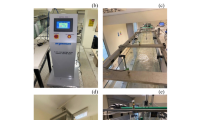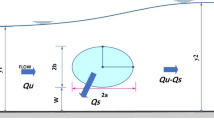Abstract
Sediment transport modeling is of primary importance for the determination of channel design velocity in lined channels. This study proposes to model sediment transport in open channel flow using kernel ridge regression (KRR), a nonlinear regression technique formulated in the reproducing kernel Hilbert space. While the naïve kernel regression approach provides high flexibility for modeling purposes, the regularized variant is equipped with an additional mechanism for better generalization capability. In order to better tailor the KRR approach to the sediment transport modeling problem, unlike the conventional KRR approach, in this study the kernel parameter is directly learned from the data via a new gradient descent-based learning mechanism. Moreover, for model construction, a procedure based on Cholesky decomposition and forward-back substitution is applied to improve the computational complexity of the approach. Evaluation of the recommended technique is performed utilizing a large number of laboratory experimental data where the examination of the proposed approach in terms of three statistical performance indices for sediment transport modeling indicates a better performance for the developed model in particle Froude number computation, outperforming the conventional models as well as some other machine learning techniques.





Similar content being viewed by others
References
De Sutter R, Rushforth P, Tait S, Huygens M, Verhoeven R, Saul A (2003) Validation of existing bed load transport formulas using in-sewer sediment. J Hydraul Eng 129(4):325–333
Safari MJS, Mohammadi M, Ab Ghani A (2018) Experimental studies of self-cleansing drainage system design: a review. J Pipeline Syst Eng 9(4):04018017
CIRIA (1986) Sediment movement in combined sewerage and storm-water drainage systems.” Phase 1. Project report. CIRIA research project No. 336, London
Safari MJS (2016) Self-cleansing drainage system design by incipient motion and incipient deposition-based models. PhD thesis, Istanbul Technical University, Turkey
Mayerle R, Nalluri C, Novak P (1991) Sediment transport in rigid bed conveyances. J Hydraul Res 29(4):475–495
May RWP (1993) Sediment transport in pipes and sewers with deposited beds. Technical Report, Hydraulic Research Ltd., Report SR 320, Wallingford, UK
Ab Ghani A (1993) Sediment transport in sewers. PhD thesis, University of Newcastle upon Tyne
Ota JJ (1999) Effect of particle size and gradation on sediment transport in storm sewers. PhD thesis, University of Newcastle Upon Tyne, UK
Ota JJ, Nalluri C (2003) Urban storm sewer design: approach in consideration of sediments. J Hydraul Eng 129(4):291–297
Ota JJ, Perrusquia GS (2013) Particle velocity and sediment transport at the limit of deposition in sewers. Water Sci Technol 67(5):959–967
Butler D, May R, Ackers J (2003) Self-cleansing sewer design based on sediment transport principles. J Hydraul Eng 129(4):276–282
Vongvisessomjai N, Tingsanchali T, Babel MS (2010) Non-deposition design criteria for sewers with part-full flow. Urban Water J 7(1):61–77
Safari MJS, Aksoy H, Unal NE, Mohammadi M (2017) Non-deposition self-cleansing design criteria for drainage systems. J Hydro-environ Res 14:76–84
Safari MJS, Aksoy H (2020) Experimental analysis for self-cleansing open channel design. J Hydraul Res. https://doi.org/10.1080/00221686.2020.1780501
Ab Ghani A, Azamathulla HM (2010) Gene-expression programming for sediment transport in sewer pipe systems. J Pipeline Syst Eng 2(3):102–106
Azamathulla HM, Ab Ghani A, Fei SY (2012) ANFIS-based approach for predicting sediment transport in clean sewer. Appl Soft Comput 12:1227–1230
Ebtehaj I, Bonakdari H, Shamshirband S, Mohammadi K (2015) A combined support vector machine-wavelet transform model for prediction of sediment transport in sewer. Flow Meas Instrum 47:19–27
Safari MJS, Aksoy H, Mohammadi M (2016) Artificial neural network and regression models for flow velocity at sediment incipient deposition. J Hydrol 541:1420–1429
Qasem SN, Ebtehaj I, Bonakdari H (2017) Potential of radial basis function network with particle swarm optimization for prediction of sediment transport at the limit of deposition in a clean pipe, Sustai. Water Resour Manag 3:391–401
Ebtehaj I, Bonakdari H, Zaji AH (2016) An expert system with radial basis function neural network based on decision trees for predicting sediment transport in sewers. Water Sci Technol 74(1):176–183
Ebtehaj I, Bonakdari H, Shamshirband S, Ismail Z, Hashim R (2016) New approach to estimate velocity at limit of deposition in storm sewers using vector machine coupled with firefly algorithm. J Pipeline Syst Eng 20:04016018
Ebtehaj I, Bonakdari H (2016) Assessment of evolutionary algorithms in predicting non-deposition sediment transport. Urban Water J 13:499–510
Najafzadeh M, Bonakdari H (2016) Application of a neuro-fuzzy GMDH model for predicting the velocity at limit of deposition in storm sewers. J Pipeline Syst Eng 8:06016003
Najafzadeh M, Laucelli DB, Zahiri A (2017) Application of model tree and evolutionary polynomial regression for evaluation of sediment transport in pipes. KSCE J Civ Eng 21:1956–1963
Roushangar K, Ghasempour R (2017) Prediction of non-cohesive sediment transport in circular channels in deposition and limit of deposition states using SVM. Water Sci Technol Water Supply 17:537–551
Roushangar K, Ghasempour R (2017) Estimation of bed load discharge in sewer pipes with different boundary conditions using an evolutionary algorithm. Int J Sediment Res 32(4):564–574
Safari MJS, Shirzad A, Mohammadi M (2017) Sediment transport in deposited bed sewers: unified form of May’s equations using the particle swarm optimization algorithm. Water Sci Technol 76(4):992–1000
Safari MJS, Danandeh Mehr A (2018) Multigene genetic programming for sediment transport modeling in sewers at non-deposition with deposited bed condition. Int J Sediment Res 33(3):262–270
Wan Mohtar WHM, Afan H, El-Shafie A, Bong CHJ, Ab Ghani A (2018) Influence of bed deposit in the prediction of incipient sediment motion in sewers using artificial neural networks. Urban Water J 15(4):296–302
Safari MJS, Shirzad A (2019) Self-cleansing design of sewers: definition of the optimum deposited bed thickness. Water Environ Res 91(5):407–416
Safari MJS (2019) Decision tree (DT), generalized regression neural network (GR) and multivariate adaptive regression splines (MARS) models for sediment transport in sewer pipes. Water Sci Technol 79(6):1113–1122
Kargar K, Safari MJS, Mohammadi M, Samadianfard S (2019) Sediment transport modeling in open channels using neuro-fuzzy and gene expression programming techniques. Water Sci. Tech. 79(12):2318–2327
Safari MJS, Ebtehaj I, Bonakdari H, Es-haghi MS (2019) Sediment transport modeling in rigid boundary open channels using generalize structure of group method of data handling. J Hydrol 577:123951
Ebtehaj I, Bonakdari H, Safari MJS, Gharabaghi B, Zaji AH, Madavar HR, Khozani ZS, Es-haghi MS, Shishegaran A, Danandeh Mehr A (2020) Combination of sensitivity and uncertainty analyses for sediment transport modeling in sewer pipes. Int J Sediment Res 35(2):157–170
Montes C, Berardi L, Kapelan Z, Saldarriaga J (2020) Predicting bedload sediment transport of non-cohesive material in sewer pipes using evolutionary polynomial regression–multi-objective genetic algorithm strategy. Urban Water J 17(2):154–162
Cortes C, Vapnik V (1995) Support vector networks. Mach Learn 20:273–297
An S, Liu W, Venkatesh S (2007) Face recognition using kernel ridge regression. In: IEEE conference on computer vision and pattern recognition, Minneapolis, MN, pp 1–7
He J, Ding L, Jiang L, Ma L (2014) Kernel ridge regression classification. In: International joint conference on neural networks (IJCNN), Beijing, pp 2263–2267
Goodfellow I, Bengio Y, Courville A (2016) Deep learning. MIT Press, Cambridge. ISBN 9780262035613
Hofmann T, Schölkopf B, Smola AJ (2008) Kernel methods in machine learning. Ann Stat 36:1171–1220
Raudkivi AJ (1990) Loose boundary hydraulics. Pergamon Press, Oxford
Vanoni VA (2006) Sedimentation engineering. ASCE, New York
Novak P, Nalluri C (1984) Incipient motion of sediment particles over fixed beds. J Hydraul Res 22(3):181–197
Safari MJS, Aksoy H, Unal NE, Mohammadi M (2017) Experimental analysis of sediment incipient motion in rigid boundary open channels. Environ Fluid Mech 17(6):1281–1298
Craven JP (1953) The transportation of sand in pipes—full pipe flow. In: Proceedings. Of the fifth hydraulics conference, bulletin 34, State University of Iowa Studies in Engineering, Iowa State University, Iowa
Ambrose HH (1953) The transportation of sand in pipes free surface flow. In: Proceeding of the fifth hydraulic conference, bulletin 34, State University of Iowa Studies in Engineering, Iowa State University, Iowa
Durand R (1953) Basic relationships of the transportation of solids in pipes. In: Experimental research, international association for hydraulic research, fifth congress, Minneapolis
Durand R, Condolois EI (1956) Donnees techniques sur le refoulement hydraulique des materiaux solides en conduite. Rev. L’Industrie Mineral, Special Number F, June
Robinson MP, Graf WH (1972) Pipelining of low concentration sand-water mixtures. J Hydr Eng Div ASCE 98 (HY7) 1221–1240
Novak P, Nalluri C (1975) Sediment transport in smooth fixed bed channels. J Hydraul Div ASCE 101(HY9):1139–1154
May RWP (1982) Sediment transport in sewers. Report No. IT 222, Hydraulic Research Station, Wallingford
May RWP, Brown PM, Hare GR, Jones KD (1989) Self-cleansing conditions for sewers carrying sediment. Report SR, 221
Mayerle R (1988) Sediment transport in rigid boundary channels. PhD thesis, University of Newcastle upon Tyne, UK
Kithsiri MMAU (1990) Sediment transport in rectangular channels with rough rigid beds. PhD thesis, University of Newcastle upon Tyne (1990)
Ackers JC, Butler D, May RWP (1996) Design of sewers to control sediment problems. Construction Industry Research and Information Association (CIRIA) Rep. No. 141, London. pp 1–181
May RW, Ackers JC, Butler D, John S (1996) Development of design methodology for self-cleansing sewers. Water Sci Technol 33(9):195–205
Alpaydin E (2010) Introduction to machine learning 2e. MIT Press, Cambridge
Baudat G, Anouar F (2000) Generalized discriminant analysis using a kernel approach. Neural Comput 12(10):2385–2404
Cortes C, Vapnik V (1995) Support-vector networks. Mach Learn 20(3):273–297
Mika S, Ratsch G, Weston J, Scholkopf B, Mullers KR (1999) Fisher discriminant analysis with kernels. In: Neural networks for signal processing IX: Proceedings of the 1999 IEEE signal processing society workshop (cat. No. 98th8468). IEEE. (1999), pp 41–48
Scholkopf B, Smola AJ (2001) Learning with kernels: support vector machines, regularization, optimization, and beyond. MIT Press, Combridge
Ethem A (2010) Introduction to machine learning, 2nd edn. MIT Press, Combridge
Berlinet A, Thomas C (2004) Reproducing kernel hilbert spaces in probability and statistics. Kluwer Academic Publishers, Dordrecht
Tikhonov AN (1943) Oб ycтoйчивocти oбpaтныx зaдaч [On the stability of inverse problems]
Saunders C, Gammerman A, Vovk V (1998) Ridge regression learning algorithm in dual variables. In: Proceedings of the 15th international conference on machine learning (ICML98), Madison-Wisconsin. pp 515–521
Golub GH, Van Loan CF (1996) Matrix computations, 3rd edn. Johns Hopkins, Baltimore. ISBN 978-0-8018-5414-9
Stewart GW (1998) Matrix algorithms: basic decompositions, vol 1. SIAM, Philadelphia
Cai D, He X, Han J (2011) Speed up kernel discriminant analysis. VLDB J 20(1):21–33
Author information
Authors and Affiliations
Corresponding author
Ethics declarations
Conflict of interest
The authors declare that the have no conflict of interest.
Additional information
Publisher's Note
Springer Nature remains neutral with regard to jurisdictional claims in published maps and institutional affiliations.
Rights and permissions
About this article
Cite this article
Safari, M.J.S., Rahimzadeh Arashloo, S. Kernel ridge regression model for sediment transport in open channel flow. Neural Comput & Applic 33, 11255–11271 (2021). https://doi.org/10.1007/s00521-020-05571-6
Received:
Accepted:
Published:
Issue Date:
DOI: https://doi.org/10.1007/s00521-020-05571-6




